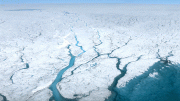
Rising global sea levels are attributed to the warming climate causing thermal expansion of sea water and ice melt from regions like the Antarctic and Greenland. However, sea level rise rates vary regionally due to changes in ocean dynamics and ‘ice sheet fingerprints’—the effect of significant ice loss from certain areas influencing Earth’s gravity and rotation.
Why is sea level rising?
So on global scales, sea level is rising really because of our warming climate.
There’s two main factors causing sea level to change.
The first is what we call thermal expansion. So as more heat gets trapped by the atmosphere, a lot of that heat gets absorbed by the ocean. When water warms, it actually expands and that causes sea level to go up.
The other reason that sea level is rising is because of melting ice. So we have a lot of ice contained in the ice sheets, the Antarctic, Greenland ice sheets and different mountain regions. As the Earth warms, these regions are also warming.
So what happens is this ice melts, and when it melts, that meltwater flows into the ocean. So again, this causes sea level to go up.
Global sea levels are rising as a result of human-caused global warming, with recent rates being unprecedented over the past 2,500-plus years. NASA JPL’s sea level rise expert Ben Hamlington explains how our warming planet is causing sea levels to rise. Credit: NASA
On regional scales, the rates of sea level rise can actually be quite different. The ocean doesn’t fill like a bathtub. Different parts of the ocean see more of an effect than others, depending on two main factors.
The first of these is something we call ocean dynamics. So as the climate changes, there can be changes in our ocean circulation, the currents, and this actually changes how water is distributed and moved about the Earth, causing sea level to be different in some locations than others.
The other reason that we see differences in the rates from one region to the next is something we call the ice sheet fingerprints. So there’s so much ice being lost from these different locations, from the ice sheets that it actually affects the gravity and rotation of the Earth.
And we have these distinct, what we call fingerprints, that really dictate where the water goes when it melts.
We Asked a NASA Expert Video Series
- Why is Venus Called Earth’s Evil Twin?
- Is NASA Really Crashing a Spacecraft Into an Asteroid?
- Is NASA Aware of Any Earth-Threatening Asteroids?
- When Was the Last Time an Asteroid Hit Earth?
- How Did Perseverance Mars Rover Pick Its Landing Spot?
- What if an Asteroid Was Going To Hit Earth?
- Did Mars Ever Look Like Earth?
- What Are Lagrange Points?
- What Are the Trojan Asteroids?
- Is There Oxygen on Mars?
- Does NASA Know About All the Asteroids?
- Do Aliens Exist?
- Is There Weather on Mars?
- Will an Asteroid Ever Hit Earth?
- Is Mars Habitable?
- Could Microbes Survive a Trip to Mars?









He forgot to mention that as water is extracted from aquifers for agriculture, it finds its way into the oceans, either directly as run off, or evapo-transpiration, and then rains out.
The variation in density with temperature (the inverse of the volume change) is quite small. The density of fresh water at 30 deg Celsius (The approximate maximum observed temperature of surface ocean water in the tropics.) is about 99.6% of what it is at zero; it reaches the maximum density at 4 deg C. The behavior of ocean water is more complex because the amount of salt dissolved (salinity) affects the density as well. That surface variation occurs primarily with latitude and is generally restricted to the upper several hundred meters of the ocean, known as the mixed layer. That is, if the water is deep enough, the density may typically change from about 1.025 to 1.028 g/cm^3. That is a change of about +/-0.0015 g/cm^3 around the mean of 1.0625, or about +/-1.5%. There is less variation at the poles because the surface water is very cold to start with.
Correction:
The last number should be +/- 0.14%, NOT 1.5%.